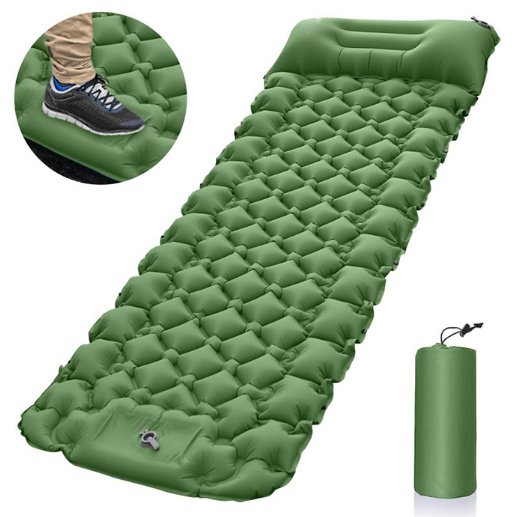Sleeping Pad: Official Guide to Outdoor Comfort
Sleeping pads play an essential role in enriching outdoor experiences, providing insulation and comfort that transforms any camping trip into a restful adventure. According to various sources, a good sleeping pad is not just a luxury; it’s a vital piece of equipment that ensures warmth, protects from the ground's chill, and enhances sleep quality, especially during long excursions when a restful night is essential for the next day’s activities.
Available in multiple varieties, including foam, self-inflating, and air pads, these products cater to diverse camping scenarios and personal preferences.
What Is a Sleeping Pad?
A sleeping pad acts as a buffer between you and the potentially harsh ground while you enjoy the great outdoors. It primarily focuses on offering insulation, comfort, and support, ensuring you stay warm and shielded from the uneven terrain below.
Key Functions:
- Insulation: Prevents body heat from dissipating into the ground.
- Comfort: Helps even out rough surfaces for an improved sleeping experience.
- Protection: Guards against sharp objects and dampness from the ground.
Do I Need A Sleeping Pad?
Absolutely, particularly if comfort, warmth, and achieving a restful night's sleep are your goals while exploring the outdoors. Here's the reasoning:
- Insulation: Even in temperate climates, the ground can sap heat from your body, leading to uncomfortable sleeping conditions. A good sleeping pad acts as an essential barrier against this.
- Comfort: Sleeping on hard or rough ground can be very uncomfortable. Using a sleeping pad offers a cushioned resting area that enhances overall comfort.
- Compactness: The latest sleeping pad models are designed to be lightweight and easily packable, making them a practical addition to your outdoor gear.
How To Choose A Sleeping Pad
Finding the perfect sleeping pad requires consideration of several key elements to ensure it meets your specific outdoor sleeping needs:
- Type: Decide between foam, self-inflating, and air pads based on your priorities, such as weight, warmth, and comfort.
- R-Value: This rating indicates the insulation ability of the pad; higher R-values offer better warmth, making them essential for colder weather.
- Weight and Packed Size: Essential factors for backpackers, as lighter and more compact pads are easier to transport. Regular (around 72 inches) and long (about 78 inches) pads can insulate your legs and feet, whereas shorter options (about 47 to 48 inches) save weight and space.
- Durability: Look for materials robust enough to handle the demands of outdoor use, especially if you're hiking in rugged conditions.
Types of Sleeping Pads
Air Pads
Air pads are available in various styles. They can be lightweight for backpacking or thicker for glamping adventures. Many now include insulation and reflective materials to boost warmth, and several designs have alternative inflation methods to ease setup.
Pros: Lightweight and compact when packed, air pads excel in comfort. Users can adjust firmness by adding or releasing air, making them versatile.
Cons: Higher-quality air pads can be pricey and susceptible to punctures or leaks, particularly in pet-friendly camping situations. Moisture accumulation can also be an issue, so using a hand pump or storing with the valves open is advisable.
Self-Inflating Pads
Self-inflating pads utilize a combination of open-cell foam insulation and air. Opening the valve allows the foam to expand and draw in air automatically. There are designs tailored for both backpacking and car camping, each offering a range of warmth, size, and price points.
Pros: These offer good comfort, decent insulation, and adjustable firmness. Typically, they are more durable than air pads.
Cons: They are heavier and more expensive than simple foam pads and can still be vulnerable to punctures, albeit they are repairable.
What To Look For In A Sleeping Pad
While shopping for a sleeping pad, keep these features in mind:
- R-Value: Ensures adequate insulation for your environment.
- Comfort: The thickness and surface texture can significantly influence the quality of your sleep.
- Ease of Use: Look for convenience in inflating, deflating, and packing the pad.
- Size: Ensure it corresponds to your body dimensions and sleeping style.
What To Put Under A Sleeping Pad
To optimize your outdoor sleeping pad, consider these additions:
- Groundsheet or Tarp: Protects the pad from sharp objects and moisture from the ground.
- Blanket or Foam Pad: For greater insulation in chilly climates, placing an additional layer underneath can help retain body heat.
Conclusion
Investing in a sleeping pad is crucial for anyone looking to enhance their outdoor sleeping experience. A well-chosen sleeping pad provides the comfort and insulation necessary for a revitalizing night beneath the stars, ensuring you wake up rejuvenated and ready for another day of outdoor exploration.
220
0
0



Comments
All Comments (0)